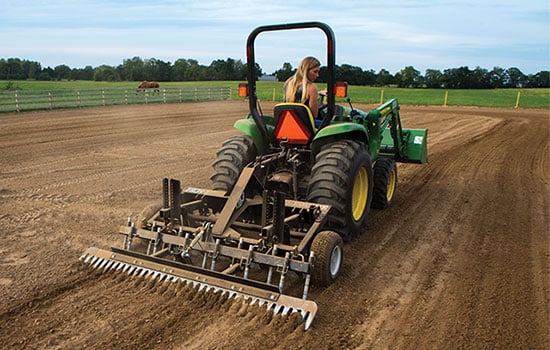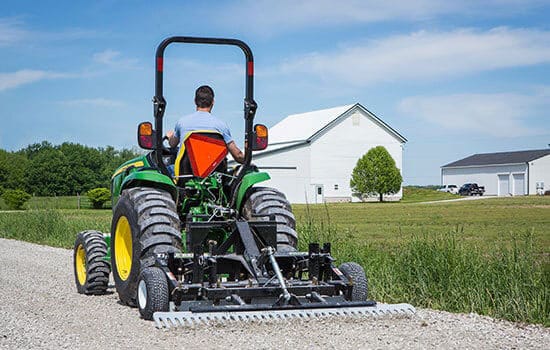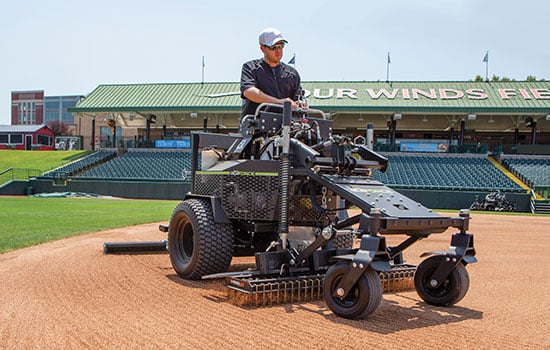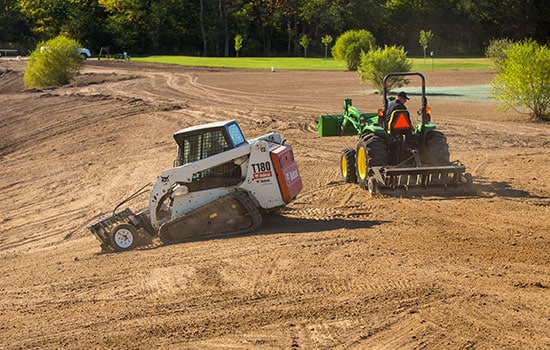On The Ground With Stanley “Dirt Monkey” Genadek I ABI Dirt
Transcript
Hi Everyone! Matt Metzger here with ABI Attachments. Welcome back to the ABI Dirt. On today’s episode we’ve got a really fun conversation with Stanley Genadek. Now, you might know Stanley Genadek better as The Dirt Monkey. Stan has been a landscape contractor his entire life in the past couple of years he has started his own YouTube channel to share some of the things he’s learned as a landscape contractor. And recently, he picked up an ABI SR3. So I want to sit down with Stan via a video call, get his first impressions on the SR3 and also pick his brain a little bit about common myths and misconceptions and how he does what he does on the job site. Here’s Stan.
Stan, let’s start out by just giving us a little bit of history, because I know you’ve been on camera for quite a while. You’ve been doing this your entire life. But how long have you actually been in kind of this landscaping, excavating hardscaping industry?
Well, I have actually ran equipment since I was about ten or eleven years old. My dad threw me on a trac excavator, a 1979 John Deere. And he said, you know what? Just go learn how to run and crush cars. So that’s where I started. And then I think I was 15, 16 years old, building dams out in the country, ponds and dams for farmers. So knocking down silos and doing that. So my entire life really. So it’s nothing new.
Wow. So is this, I mean, is this what you always wanted to do? I mean, like, give us that, like, childhood dream. Like, did you always imagine yourself in excavators, crushing cars and building stuff out of dirt?
No, absolutely not. I you know, my dream, my honest to God dream was always just to help people. It wasn’t to be a contractor. It was, I just always wanted to help people in some way, shape or form. But I had to be a contractor to learn how to feed myself and help myself, first and foremost. And so then it was decades of just grinding and learning and making mistakes and screwing up and then recovering from those mistakes and then realizing that as I was growing, I would have never survived if it wasn’t for my dad helping me the entire way. Right. And so then when he passed away, I realized, wait a minute, you know, my dad built me. Who’s helping build the other guys that may be like me that want a chance but don’t have somebody to help them. And so I just went on YouTube and started giving away everything that I possibly could, all the knowledge, skill, experience, everything I ever did. I just gave it away. Good, bad or in between. If people accepted it, fine, if they didn’t. I’m okay with that. I don’t care. I don’t need their embrace. I don’t need them to like me because maybe the next guy behind the scenes it helped.
So Stan. Let’s talk a little bit about the SR3, because when you and I first talked and we were talking with you about the kind of projects you’re working on and what you’re trying to tackle, when we first talked SR3, you almost brushed it aside as something. Well, that’s obvious, of course. Of course I could put that to use. What about what about the SR3, having never used one before, just from our conversation about what it can do; What made you so confident without ever kicking the tires on it?
Well, you know, it was impressive. The video that I’ve seen from you guys was very impressive. And so then I was a little bit excited about giving it a shot. But no, after actually using it, I find that it is kind of like a Harley rake on steroids, I think would be the best way to to describe it, because not only will it do everything that a Harley rake will do, but it will do the next step. And that’s give you the control as the operator to scarify and loosen up the soil to the depth that you want. You don’t get that ability with a Harley rake. You don’t have the ability to to create a nice loose topsoil bread, you know, to go into a hyper compacted area and to rip it up and then to grade it at the exact same time. A Harley rake will loosen up just a little bit, but underneath that, it’s compacting everything below it. Where would this thing you’re driving these forks in there. You’re turning that up down below. And then you’re fine grading at the same time. That’s where this thing is not like a Harley rake. But it’s like everything a Harley rake is plus more. That’s what I’m finding.
So where do you find this fitting in your process then? I know you got, I mean, even just from seeing different videos at your property, you got loads of equipment out there. You got you just recently added a man to the team. So how often do you see using this thing? And I mean, just looking into your summer and how much work you got, how many sites you think you can pull this out on?
Well, I know that this is going to be going to a lot of our grading jobs. Well, we’ve already started to put in jobs on the schedule that we were going to be taking on. Period. Because now we have more capabilities because of it. So we’ve got a big job coming up where we’ve got to grade this entire area. It’s been compacted. There was buildings there. And so now this is like, oh, we’ve got the perfect tool for this. We don’t have to bring out all these other things and try to figure out how to do this. It’s a one and you’re done scenario. So we’re finding, and we’re still early in this process, right? I mean, we’ve literally just put it to the real test just here the last time and graded this area out. And it turned out to be I call it a pool table top. That’s what my dad used to call them. Right. Just butter-smooth, right? And so with that kind of capability, we’re a little excited to give it a go on other projects. So and we’ve got some that were specifically got this tool in mind for.
What I appreciated about your first look at that SR3 is that you gave us a really raw footage. I mean, you didn’t call me anytime. You didn’t call our engineers ahead of time. You took out of the box and put it in and gave it a go. And I love it. And you mentioned at one point that you think it takes about four to six hours even for a skilled operator to get a feel for this thing. And now that’s that’s saying a lot coming from you because you’re your master skidsteer operator. So I mean, like you said, you’ve been doing this since your twelve, 13 years old. So talk to me about that learning curve. What specifically do you recommend for other people who are trying out an SR3 for the first time how to help them navigate through that learning curve?
OK. The best thing I can say is you guys made a video showing all of the different capabilities. And in that video, you guys talk about how you can grade going forward and you can grade going backward. And as I watched that video was started to click all of these aha moments so that when I went out and actually used it on my own, I remembered how they use the wheels and the angle to get the front rakers to hit everything up and the angle that back and then how you tip it back and you go forward and you grab. And all I literally did was play that video back in my mind as I was running the equipment and I didn’t put four or six hours on it. And I had it on. I put literally probably, I would say about a half hour to an hour. And I was just like, oh, this is this is this is nice. This is very nice. So and I just said the four to six hour range, because I’m assuming that guys haven’t been doing this for 30 plus years. And you know I don’t want to paint a picture where a guy can do it and 30 minutes to an hour and have it done. I’d rather paint a picture where the average guy can come in here, mess around with it, and in a half a day, you’re pretty confident using it. So that was kind of the difference of how we you know, how I did it. And I was just trying to put myself in their shoes a little bit more.
Well and I like that you pointed out there that it was much quicker for you to pick up. You’ve been doing this for 30 years. Talk to me about the ability for your crew to jump on this as well, because you can’t be everywhere at once. You’ve got a lot of irons in the fire. How easy is it gonna be for some of your guys that aren’t as familiar with equipment as you are to pick this up and get a high quality result out of it?
Well, I know both Blaine and Sam out of my project, ran it. And if these guys haven’t seen the video, you’ll see them actually jumping in it and using it for the first time and looking at the results; they messed around with it for about what I figured, about the four to six hour range and then I looked I just looked at the results when it was done. It was pretty much flawless. So they just told me that, yeah, we were right on board with what we were estimating.
And honestly, Stan, just a for our use, if there is anything in your first kind of impression of this tool. Is there anything about it that you would want to add any feedback to say, man, guys, you’ve got this real close, but is there any way you can dial this in tighter?
I don’t know how you could make it better. I don’t. I just I mean. I just it worked. It did everything, it did everything and more. I’ve never used anything like it, Matt. I mean, I don’t know what else to say. I’d never use anything like it. I know. How do you. I mean. No, I it just it just did it. Now I’m going to be running it a lot more. We’ve got a lot of projects coming up and it’s going to be put to the test. I mean, we’re going to be taking it and we’re going to be I would say the best thing to do is revisit this subject a year from now when we beat the snot out of this thing for twelve months. That’s really when you know a guy can tell because that’s when it starts to really pay for itself. And we’re going to see how well it holds up and how well is it not just to me but to my crew. That’s really the ultimate test. When you put a guy on it that doesn’t give a rat’s behind how well this thing holds up and he’s just got to get a job done. You know, your cruise use and abuse your tools weigh more than an owner operator ever does. I mean, if it was just left in my hands, this thing would look shiny. I would use it. But no, my guys are gonna beat the crap out of it. We’ll see how well it holds up. That’s where the real test will come.
That’s awesome. Well, good. Well Stan, I am I’m thrilled that you were willing to give this thing a shot and then you and you take a chance on something you’ve never seen before. And I’m. I’m glad you like it, man. I’m glad it will do the job for you.
I’m very impressed. It actually over-performed. So, that I don’t get to say very often, but it definitely over-performed.
Stan, thanks so much for your time and really appreciate it. And thank you to for sharing what you’ve learned with the rest of us. Love that you’re making that YouTube channel like your open book so we can all learn from you, both your successes and your mistakes. Glad you like the SR3 and for any of you out there who are also interested in the SR3 if you’ve never had a chance to dig into it, check out the video link in the description below. And as always, our factory reps are available to you to answer and further questions. Until next time everybody, take care.



